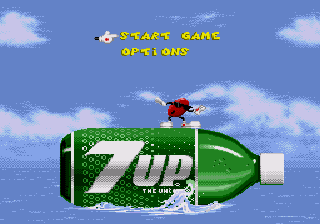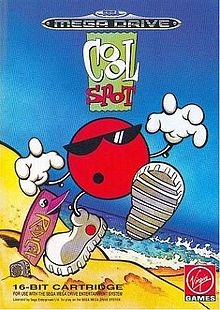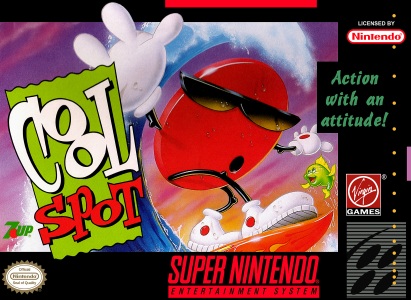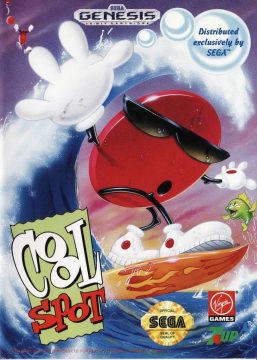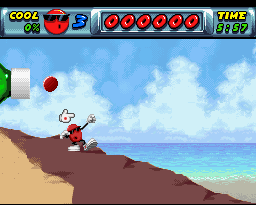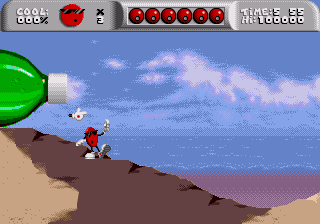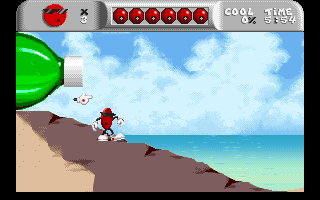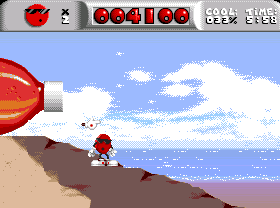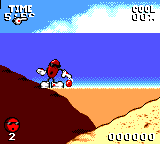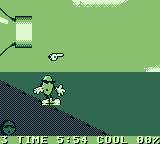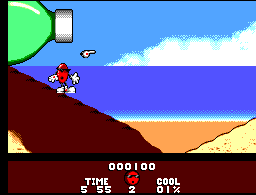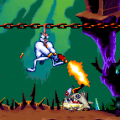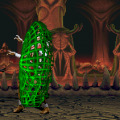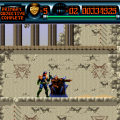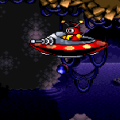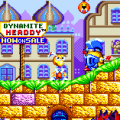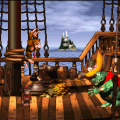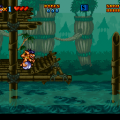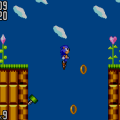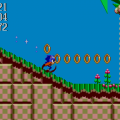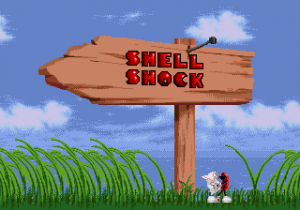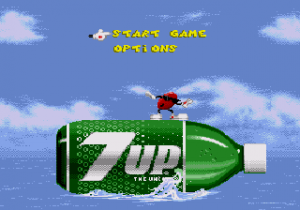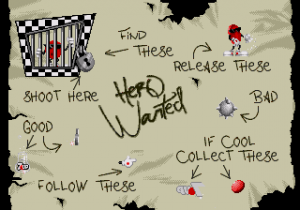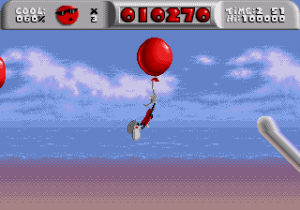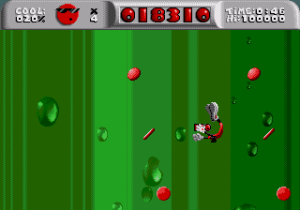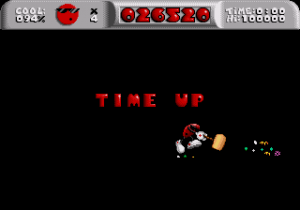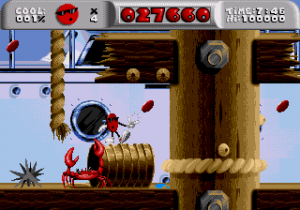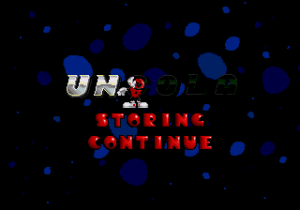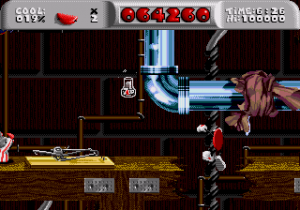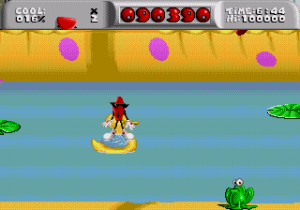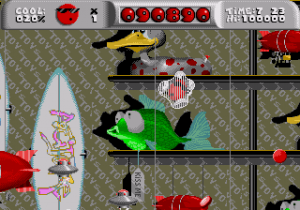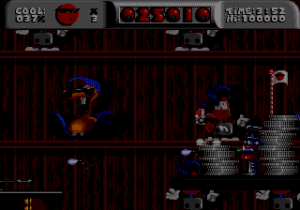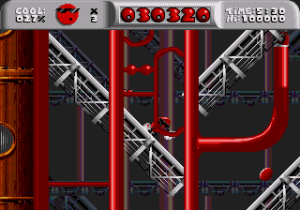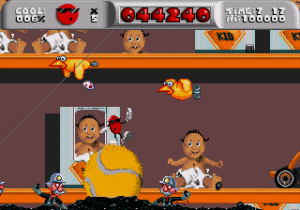Virgin would give a Spot platformer another shot for the 16-bit systems of the era, and although the result is far from amazing, Cool Spot is a damn sight better than The Cool Adventure. It’s also pretty much the only game in the Spotseries that people actually remember, probably for all the systems it came out on for its release. While it shares more than a few similarities in gameplay with another McDonald’s game, Global Gladiators, it’s still unique enough it’s worth playing. That is, if you’re the sort of person who seeks out mascot platformers and you’ve sucked all enjoyment out of Yo! Noid. The nearly non-existant plot to this game is that somebody has captured a bunch of Spot’s identical clones and locked them in cages. Who did this? What’s their plan? Hey, when you’re as cool as Spot, things like “story” and “motivation” are squaresville, man.
The goal of each stage is to collect “cool points” which are the little red circles scattered all over the level. The levels aren’t strictly left to right affairs, since you’re generally supposed to search all over to grab all the hidden cool points. You’re generally sort of gently guided to the cage by a bunch of pointing fingers scattered over the level, and there’s usually only one path to the exit. Don’t dally for too long, however, because you’re on a time limit. Try not to run out of time, because the warning sound the game makes is incredibly annoying. So annoying, in fact, that Spot will smash the alarm clock it’s apparently coming from into bits if you run out of time, which is a nice touch.
If you’re playing on the standard difficulty, you’ll need 60 of the hundred cool points scattered across the stage. Once you do that, you’ll be able to shoot open the cage at the level, which contains one of your captured identical clones. If you manage to find 85 of the cool points, you’ll go to a bonus stage. These put you inside a 7-Up bottle, where you use the bubbles inside to grab extra cool points for a shot at an extra life. There’s also a letter somewhere inside the bottle, one of which that spells the word “UNCOLA”. You know, 7-Up. Each letter is also a continue, so they’re worth seeking out.
Your main way of dispatching enemies is by shooting energy blasts at them, of which you get an unlimited supply. Actually, it’s not clear if they’re energy blasts or something like carbonation, but the back of the box mentions that Spot gives enemies “the deep freeze” so maybe he’s shooting ice? Enemies are also a lot more dangerous this time around, since they can do things like throwing projectiles, dropping down from the ceiling, and blocking your shots. It helps, however, that Spot’s blasts can be aimed in any direction, even while he’s moving. The problem is that on quite a few versions of the game, you absolutely can’t shoot in place. This means that if you’re fighting an enemy at an angle to you, you have to wander back and forth to keep your shots at that angle, and doing this will often mean you’ll walk right into an enemy or a hazard.
Enemy hits can pile up on you quickly, mostly because you don’t get much invincibility time between hits. Your health is represented by Spot’s face, which slowly peels off of the screen as you take damage until it falls off entirely. It’s an interesting visual touch, but it also means it’s a little hard to gauge exactly how much health you have, and thus, how paranoid you should be about what’s coming up. Part of this is that the camera is zoomed in farther than it should be, which can mean that enemies can sneak up on you more than you’d like. The game also likes to bunch a bunch of enemies near each other, too, so while you’re trying to take out an enemy on the ground, you’ll often have another enemy flying around ramming into you. The game is nice enough to make sure that enemies you kill will stay dead, even when you die, so it all boils down to attrition.
The controls are kind of touchy, which doesn’t help with the difficulty all that much. For one thing, Spot tends to move pretty slowly, and he’ll only pick up speed if you move in one direction for a few seconds. This isn’t so bad when you’re going through unexplored territory, but when you’re trying to backtrack, it just makes the movement feel sluggish. Another issue is if you want Spot to have any real horizontal momentum to his jumps, Spot has to be moving. The problem here is that there are a lot of platforms that are just too small for Spot to get enough momentum for a big jump. And a lot of these platforms tend to be over bottomless pits or water.
Without figuring the enemy count into things, most of the level designs are decent, except for a couple of stages in particular. These stages are set around what appears to be some kind of swimming pool in a store of some sort, and if Spot hits water, he dies instantly. The problem is that a good portion of this level involves blind leaps across the lilypads and toys floating across the water, with each platform just off screen. A good chunk of the level takes place with a bunch of toys above the pool, but even then, if you end up falling off, you’ll more than likely fall right into the water, anyway. And with the controls the way they are, that’s far more likely than it should be.
When the levels aren’t overly difficult, however, they’re just kind of boring. The levels themselves look pretty great. Spot is apparently really tiny, so when you’re on the beach, things like volleyball nets tower above you, while enemies like hermit crabs are actually bigger than Spot. The stages set in somebody’s attic are interesting, too, since you can use mousetraps to catapult yourself forward, and climb across wires. The level designs are pretty all right, since they’re nice to look at, but none of them are ever as interesting or as exciting as your average Sonic the Hedgehoggame. Aside from the occasional new element, every level just involves wandering around and collecting stuff. And there still aren’t any boss fights for any variety. Even worse, by the time you reach the halfway point of the game, the level types start to repeat themselves, so the game ends on the same beach you started it on. Probably the most interesting stage in the game is Radical Rails, a level made entirely of slopes and vaccum tubes. Since this stage doesn’t have any enemies, most of it is spent watching Spot roll all over the level, which is fun to watch, if not especially engaging.
On the more positive side of things, the game looks pretty great for the time. He might not be up to the standards of say, Aladdin, but Spot has a lot of animations to him. He’s got the required level of attitude all decent mascots have, like snapping his fingers to nothing in particular while you’re standing still. He actually has quite a bit of personality to him, a lot more than other mascots like Ardy Lightfoot. The levels themselves look good, too, and they’ve got lots of little details if you take the time to look around. The pier stages have knots in the ropes you climb across, old cans laying across the ground, and holes forming in the woodwork, for example. The music doesn’t really stand out, aside from the music used in the bonus stages, which is a cool techno/rave theme. Spot also makes a lot of squeaky vocalizations, but since he doesn’t really speak, he’s generally never annoying to listen to.
Overall, Cool Spot is a decent game, but it’s nothing really amazing. It’s a very pretty game, but the trade off is that it tends to be wear on your patience pretty quickly. It also doesn’t do a lot to stand out, which means that most other platformers stacked next to it are going to look a lot better in comparison. It is, however, a much better game than Cool Adventure. It’s also a lot better than its sister Virgin advergame, Global Gladiators, in that it doesn’t make you play through what’s basically the same level five times in a row. Plus, it doesn’t have that whole “enviromental” thing going on, which makes Cool Spot slightly less, ah, dated. The lead programmer, David Perry, would go on to make the Earthworm Jim games, which kept the high-quality animation of Cool Spot, while making the game itself much, much more fun.
The Super Nintendo version came out some time after the Genesis version, so it’s had a few improvements. While none of these changes vastly improve the game, they do make it a little more enjoyable to actually play. The biggest change is that by holding down the R button, you can now actually stand in place and fire your shots, which means you don’t have to walk around to aim diagonally any more. This does make the game a lot easier, although a lot of the issues of the game still remain. A lot of the graphics have also been redrawn to look nicer, and some of the levels have extra graphics in them. In a spot on the beach level where there previously wasn’t anything, for example, there’s now a “Walkspot” tape player.
The Game Boy version is more or less a cut-down version of the Genesis version. The problem with this version is that it plays much more slowly than the other versions, which means it takes much more time to cover the same distance. A lot of the animation frames and background details are missing, as well, and most of the music didn’t make the transition pretty well. It’s better than Cool Adventure, although there are still much better platformers.
The Game Gear and Master System versions are mostly identical, aside from the MS version having the edge on screen size. Gameplay wise, they both feel like colorized versions of the Game Boy version. They aren’t quite as slow as the Game Boy version, but there’s still a lack of speed compared to the console versions. They do sound a little closer to the console version, though, except for the sound Spot makes when he jumps, which sounds like it was ripped directly from an Atari 2600. Considering how often you’ll be jumping, this will get very annoying, very quickly.
The DOS version looks and plays pretty much identically to the Genesis version, except that the music isn’t quite as good, due to it being played through an Adlib.
The Amiga version is probably one of the worst versions, if only just above the Game Boy version. It doesn’t play as quickly as the Genesis version, and it’s almost as slow as the Game Boy version. It’s not quite as colorful as the Genesis version either, since the Amiga model this runs on has a smaller color pallete. The worst thing of all, though, is that it only uses one button for shooting. This means that not only can you not shoot in place, you can’t even fire upwards without jumping. So if you want to hit anything above you, have fun ramming your face into it while you’re trying to hit it. Some of the soundtracks sound great with the Amiga’s sound hardware, like the title theme. A lot of the other tracks, sadly, sound completely off-tune.
One thing that all the PAL versions of this game share is that they all have nothing to do with 7-Up. In Europe, 7-Up’s mascot was an entirely different character named Fido Dido, who came very close to getting a game of his own. Even though Spot never had any commercials over there, Virgin released the game in the PAL territories anyway. Every mention of 7-Up has been removed from the game entirely in these versions. So the bottle Spot rides on in the title screen is now blank, the health pickups are bottles of mysterious clear liquid with Virgin’s logo on them, and you spell out “VIRGIN” instead of “UNCOLA” to get continues.
